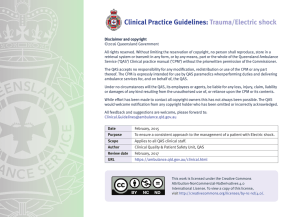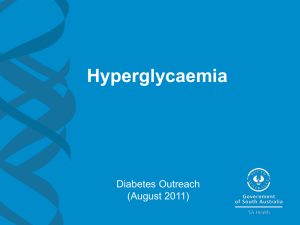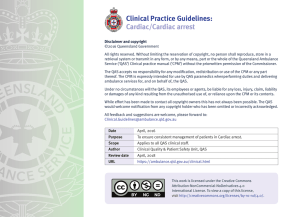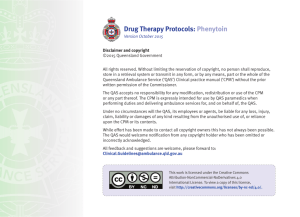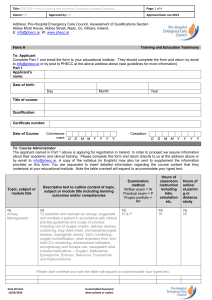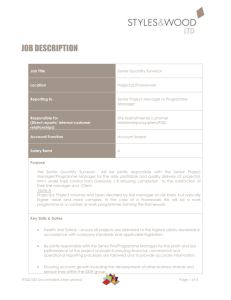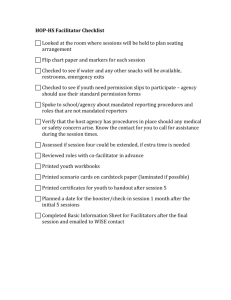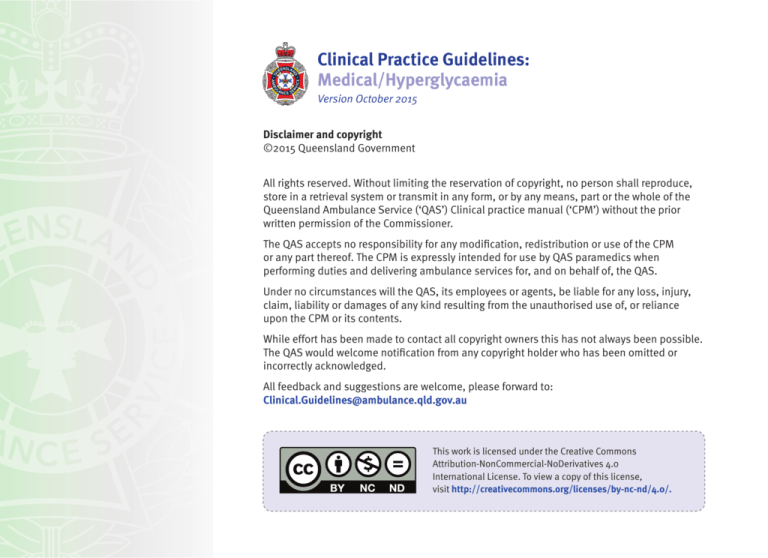
Clinical Practice Guidelines:
Medical/Hyperglycaemia
Version October 2015
Disclaimer and copyright
©2015 Queensland Government
All rights reserved. Without limiting the reservation of copyright, no person shall reproduce,
store in a retrieval system or transmit in any form, or by any means, part or the whole of the
Queensland Ambulance Service (‘QAS’) Clinical practice manual (‘CPM’) without the prior
written permission of the Commissioner.
The QAS accepts no responsibility for any modification, redistribution or use of the CPM
or any part thereof. The CPM is expressly intended for use by QAS paramedics when
performing duties and delivering ambulance services for, and on behalf of, the QAS.
Under no circumstances will the QAS, its employees or agents, be liable for any loss, injury,
claim, liability or damages of any kind resulting from the unauthorised use of, or reliance
upon the CPM or its contents.
While effort has been made to contact all copyright owners this has not always been possible.
The QAS would welcome notification from any copyright holder who has been omitted or
incorrectly acknowledged.
All feedback and suggestions are welcome, please forward to:
Clinical.Guidelines@ambulance.qld.gov.au
This work is licensed under the Creative Commons
Attribution-NonCommercial-NoDerivatives 4.0
International License. To view a copy of this license,
visit http://creativecommons.org/licenses/by-nc-nd/4.0/.
Hyperglycaemia
October, 2015
Hyperglycaemia is defined as a fasting blood glucose level (BGL) greater
than 7 mmol/L.[1] In the diabetic patient hyperglycaemia can present as
Diabetic Ketoacidosis (DKA), Hyperosmolar Hyperglycaemic Syndrome
(HHS) or be asymptomatic.
HHS is a life-threatening complication of Type 2 Diabetes Mellitus (T2 DM) that is characterised by:
UNCONTROLLED WHEN PRINTED
DKA and HHS are predominantly caused by:[2]
• Hyperglycaemia
• Hyperosmolarity
• Severe dehydration.
• Acute illness (e.g. infection, ACS, CVA)
• Non-compliance with medication.
DKA is a life-threatening complication usually seen in patients with Type 1 Diabetes Mellitus that is characterised by:
NOTE: HHS has been known by numerous names, UNCONTROLLED WHEN PRINTED
• Hyperglycaemia
• Ketosis
• Metabolic acidosis.
most notably Hyperosmolar Hyperglycaemic Nonketotic Syndrome (HHNS) and Hyperglycaemic Hyperosmolar Nonketotic Coma (HONK), however HHS is more widely accepted now, as coma is not a prerequisite and patients may present with some degree of ketosis.
It is caused by an absolute insulin deficiency or resistance UNCONTROLLED WHEN PRINTED
precipitating a number of physiological changes:
• High BGL increases blood osmolarity drawing water out of cells resulting in cellular dehydration.
• High BGL in the kidney filtrate results in osmotic diuresis and polyuria leading to severe dehydration & hypovolaemia. (fluid deficits typically range from 5–8 litres)[3]
HHS is caused by a relative insulin deficiency, whereby there is sufficient insulin to limit ketone production thus preventing
metabolic acidosis. It most commonly presents in patients > 60 and may be the primary presentation of T2 DM.[5,6,7] Grossly elevated BGLs still initiate the triad of polyuria,
polydipsia and polyphagia, and fluid deficits typically range from 8 – 10 litres.[5] HHS has a greater rate of mortality due to the severity of underlying illness, typically sepsis.
UNCONTROLLED WHEN PRINTED
• Alternative fuel sources, including fatty acids, are used, producing organic acids known as ketones. Accumulation of these result in a metabolic acidosis.[4]
• Dehydration leading to polydipsia.
Figure 2.19
• Loss of potasssium from the body.
QUEENSLAND AMBULANCE SERVICE
86
Clinical features
e
The clinical features of DKA and HHS are similar:
Neurological:
Additional information
• Note – Although treatment for severe dehydration may be required, correcting fluid deficits too quickly can cause cerebral oedema – especially in children.[8,9]
UNCONTROLLED WHEN PRINTED
• Lethargy
• ALOC
• Seizure
• Coma.
Cardiovascular:
Note: Officers are only to perform procedures for which they have received specific training and authorisation by the QAS.
CPG: Paramedic Safety
CPG: Standard Cares
• Signs of hypovolaemia (hypotension,
tachycardia)
UNCONTROLLED WHEN PRINTED
• Pale, cool or clammy or
• Flushed, hot if febrile.
The exceptions are:
Evidence of:
• Severe dehydration?
• Altered perfusion status?
• BGL: DKA (> 10 mmol/L) AND/OR HHS (> 40 mmol/L)
N
Y
UNCONTROLLED WHEN PRINTED
• Kussmaul respiration is due to the severe
metabolic acidosis. This is usually not seen in HHS.
Risk Assessment
Consider:
•
•
•
•
IV access
IV fluid
Oxygen
12-Lead ECG
Transport to hospital
UNCONTROLLED WHEN PRINTED
• Not applicable
If 12-Lead ECG is consistent with hyperkalaemia, consider:
•
•
•
Pre-notify as appropriate
Calcium gluconate 10%
Sodium bicarbonate 8.4%
Salbutamol
QUEENSLAND AMBULANCE SERVICE
87

